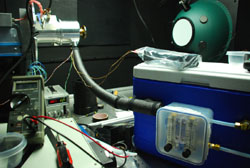De-Spun Rocket Imager
The MIRL rocket imager has flown on multiple sounding rocket payloads (ROPA, CASCADES2, RENU2) to image the aurora and the magnetic footprint of the payload from above not only for scientific data but also to provide context for other measurements. The design of the imager addresses certain technical problems involved in imaging from a spinning spacecraft.
ROPA imagers (photo: Hyomin Kim)
Image blurring due spinning of the payload is minimized by de-spinning the imager CCD. This is achieved within the imager via a rotating platform, based on existing gyroscope designs currently in use on sounding rockets. An Electron Multiplying CCD and supporting electronics are mounted on a rotating platform. The rotating platform attaches to the outer aluminum housing of the imager with SilverThin precision ball bearings from Mechatronics, Inc. and will be rotated using a Maxon Re-16 DC motor. In flight, the rotation speed of the platform can be controlled with a closed loop feedback from a roll-rate sensor. Contact is made with the CCD via slip rings by Moog Components Group.
The EMCCD from e2V Technologies does not require an intensifier, but rather, the intensification process is integrated into the operation of the CCD itself. This is achieved via an electron multiplying register, which quickly intensifies an incoming signal before it is affected by readout noise from the output amplifier of the CCD. Thus the signal-to-noise ratio of the image is increased. Also, the ability of the CCD to intensify signals eliminates the need for additional, rotating, optical components.
CASCADES2 cooling (photo: Hyomin Kim)
The CCD is cooled via a large aluminum heat sink; a large temperature gradient between the CCD and heat sink is set up prior to launch via the controlled flow of cooled nitrogen gas through the imager enclosure.



